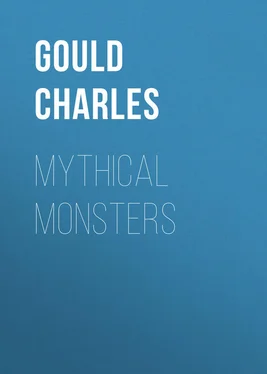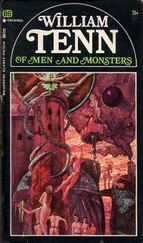Charles Gould - Mythical Monsters
Здесь есть возможность читать онлайн «Charles Gould - Mythical Monsters» — ознакомительный отрывок электронной книги совершенно бесплатно, а после прочтения отрывка купить полную версию. В некоторых случаях можно слушать аудио, скачать через торрент в формате fb2 и присутствует краткое содержание. Жанр: Мифы. Легенды. Эпос, Природа и животные, foreign_antique, foreign_prose, на английском языке. Описание произведения, (предисловие) а так же отзывы посетителей доступны на портале библиотеки ЛибКат.
- Название:Mythical Monsters
- Автор:
- Жанр:
- Год:неизвестен
- ISBN:нет данных
- Рейтинг книги:5 / 5. Голосов: 1
-
Избранное:Добавить в избранное
- Отзывы:
-
Ваша оценка:
- 100
- 1
- 2
- 3
- 4
- 5
Mythical Monsters: краткое содержание, описание и аннотация
Предлагаем к чтению аннотацию, описание, краткое содержание или предисловие (зависит от того, что написал сам автор книги «Mythical Monsters»). Если вы не нашли необходимую информацию о книге — напишите в комментариях, мы постараемся отыскать её.
Mythical Monsters — читать онлайн ознакомительный отрывок
Ниже представлен текст книги, разбитый по страницам. Система сохранения места последней прочитанной страницы, позволяет с удобством читать онлайн бесплатно книгу «Mythical Monsters», без необходимости каждый раз заново искать на чём Вы остановились. Поставьте закладку, и сможете в любой момент перейти на страницу, на которой закончили чтение.
Интервал:
Закладка:
I omit discussing the doubtful assertions of the extreme antiquity of man, which come to us from American observers, such as are based on supposed footprints in rocks of secondary age, figured in a semi-scientific and exceedingly valuable popular journal. There are other theories which I omit, both because they need further confirmation by scientific investigators, and because they deal with periods so remote as to be totally devoid of significance for the argument of this work.
Nor, up to the present time, are the evidences of the existence of man during Miocene and Pliocene times admitted as conclusive. Professor Capellini has discovered, in deposits recognised by Italian geologists as of Pliocene age, cetacean bones, which are marked with incisions such as only a sharp instrument could have produced, and which, in his opinion, must be ascribed to human agency. To this view it is objected that the incisions might have been made by the teeth of fishes, and further evidence is waited for.
Not a few discoveries have been made, apparently extending the existence of man to a much more remote antiquity, that of Miocene times. M. l’Abbé Bourgeois has collected, from undoubted Miocene strata at Thenay, supposed flint implements which he conceives to exhibit evidences of having been fashioned by man, as well as stones showing in some cases traces of the action of fire, and which he supposes to have been used as pot-boilers. M. Carlos Ribeiro has made similar discoveries of worked flints and quartzites in the Pliocene and Miocene of the Tagus; worked flint has been found in the Miocene of Aurillac (Auvergne) by M. Tardy, and a cut rib of Halitherium fossile , a Miocene species, by M. Delaunay at Pouancé.
Very divided opinions are entertained as to the interpretation of the supposed implements discovered by M. l’Abbé Bourgeois. M. Quatrefages, after a period of doubt, has espoused the view of their being of human origin, and of Miocene age. “Since then,” he says, “fresh specimens discovered have removed my last doubts. A small knife or scraper, among others, which shows a fine regular finish, can, in my opinion, only have been shaped by man. Nevertheless, I do not blame those of my colleagues who deny or still doubt. In such a matter there is no very great urgency, and, doubtless, the existence of Miocene man will be proved, as that of Glacial and Pliocene has been, by facts.” Mr. Geikie, from whose work — Prehistoric Europe – I have summarized the above statements, says, in reference to this question: “There is unquestionably much force in what M. Quatrefages says; nevertheless, most geologists will agree with him that the question of man’s Miocene age still remains to be demonstrated by unequivocal evidence. At present, all that we can safely say is, that man was probably living in Europe near the close of the Pliocene period, and that he was certainly an occupant of our continent during glacial and interglacial times.”
Professor Marsh considers that the evidence, as it stands to-day, although not conclusive, “seems to place the first appearance of man [in America] in the Pliocene, and that the best proofs of this are to be found on the Pacific coast.” He adds: “During several visits to that region many facts were brought to my knowledge which render this more than probable. Man, at this time, was a savage, and was doubtless forced by the great volcanic outbreaks to continue his migration. This was at first to the south, since mountain chains were barriers on the east,” and “he doubtless first came across Behring’s Straits.”
I have hitherto assumed a certain acquaintance, upon the part of the general reader, with the terms Eocene, Miocene, and Pliocene, happily invented by Sir Charles Lyell to designate three of the four great divisions of the Tertiary age. These, from their universal acceptation and constant use, have “become familiar in our mouths as household words.” But it will be well, before further elaborating points in the history of these groups, bearing upon our argument, to take into consideration their subdivisions, and the equivalent or contemporary deposits composing them in various countries. This can be most conveniently done by displaying these, in descending order, in a tabular form, which I accordingly annex below. This is the more desirable as there are few departments in geological science which have received more attention than this; or in which greater returns, in the shape of important and interesting discoveries relative to man’s existence, have been made.
Comparatively recent – comparatively, that is to say, with regard to the vast æons that preceded them, but extending back over enormous spaces of time when contrasted with the limited duration of written history, – they embrace the period during which the mainly existing distribution of land and ocean has obtained, and the present forms of life have appeared by evolution from preceding species, or, as some few still maintain, by separate and special creation.
THE TERTIARY OR CAINOZOIC AGE.
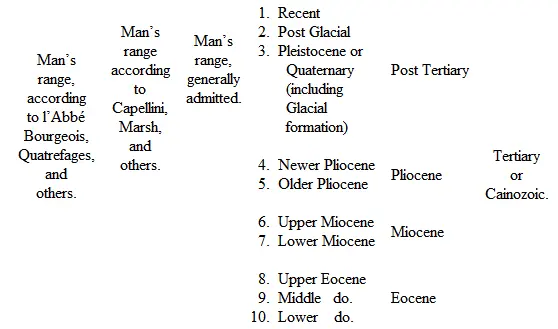
PLIOCENE.
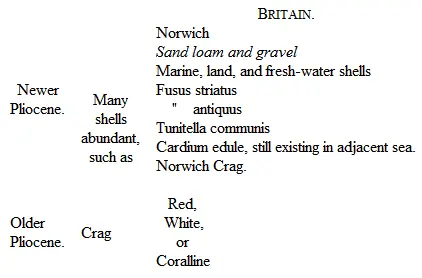
MIOCENE.
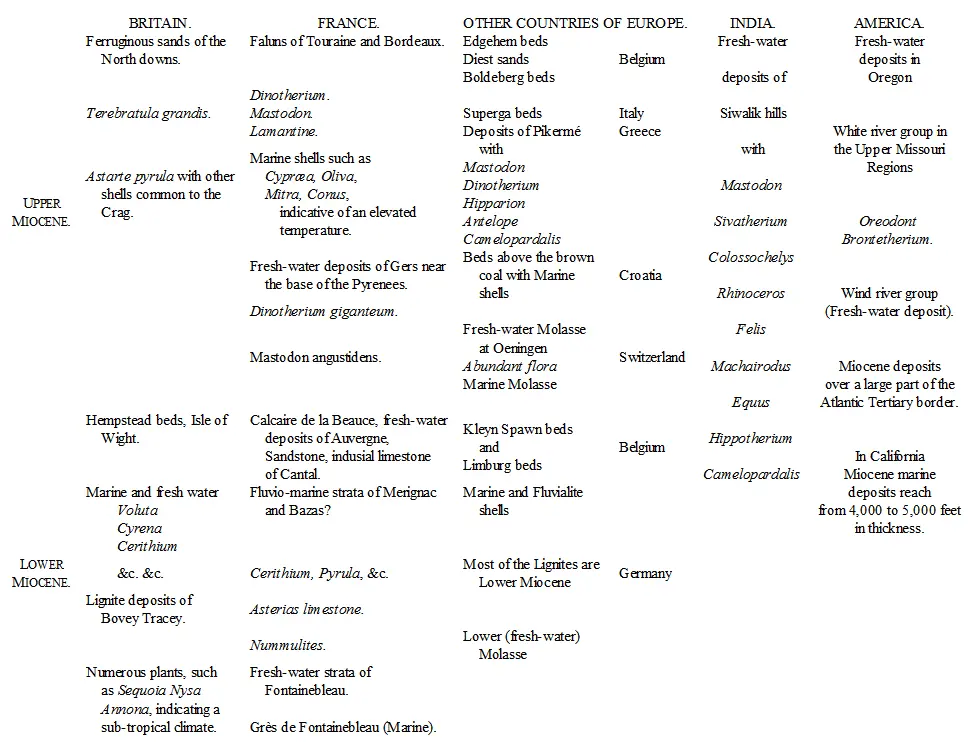
The subdivisions of the Eocene have been worked out in great detail in Britain, France, and America. Those of most other countries have either not yet been fully studied or their exact equivalence remains undetermined.
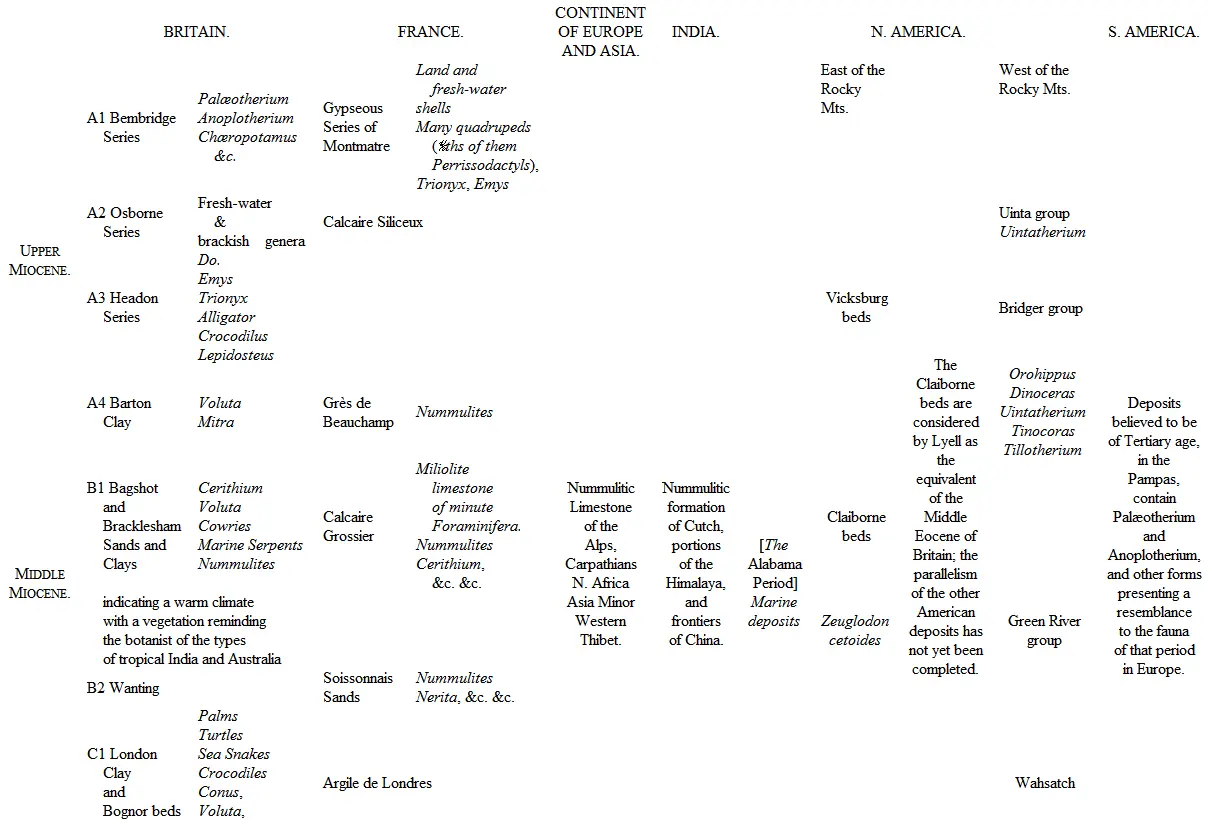

We learn, both from the nature of these deposits and from their organic contents, that climatic oscillations have been passing during the whole period of their deposition over the surface of the globe, and inducing corresponding fluctuations in the character of the vegetable and animal life abounding on it. A complete collation of these varying conditions at synchronous periods remains to be achieved, but the study of our own country, and those adjacent to it, shows that alternations of tropical, boreal, and temperate climate have occurred in it; a remarkable series of conditions which has only lately been thoroughly and satisfactorily accounted for.
Thus, during a portion of the Eocene period a tropical climate prevailed, as is evidenced by deposits containing remains of palms of an equatorial type, crocodiles, turtles, tropical shells, and other remains attesting the existence of a high temperature. The converse is proved of the Pleistocene by the existence of a boreal fauna, and the widespread evidences of glacial action. The gradations of climate during the Miocene and Pliocene, and the amelioration subsequent to the glacial period, have resulted in the gradual development or appearance of specific life as it exists at present.
Corresponding indications of secular variability of climate are derived from all quarters: during the Miocene age, Greenland (in N. Lat. 70°) developed an abundance of trees, such as the yew, the Redwood, a Sequoia allied to the Californian species, beeches, planes, willows, oaks, poplars, and walnuts, as well as a Magnolia and a Zamia. In Spitzbergen (N. Lat. 78° 56′) flourished yews, hazels, poplars, alders, beeches, and limes. At the present day, a dwarf willow and a few herbaceous plants form the only vegetation, and the ground is covered with almost perpetual ice and snow.
Читать дальшеИнтервал:
Закладка:
Похожие книги на «Mythical Monsters»
Представляем Вашему вниманию похожие книги на «Mythical Monsters» списком для выбора. Мы отобрали схожую по названию и смыслу литературу в надежде предоставить читателям больше вариантов отыскать новые, интересные, ещё непрочитанные произведения.
Обсуждение, отзывы о книге «Mythical Monsters» и просто собственные мнения читателей. Оставьте ваши комментарии, напишите, что Вы думаете о произведении, его смысле или главных героях. Укажите что конкретно понравилось, а что нет, и почему Вы так считаете.
